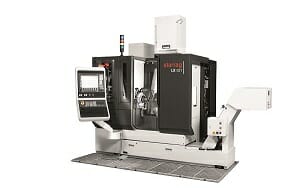In a world first, Starrag has designed, developed and fully integrated a flexible manufacturing system (FMS) for the automated complete machining – incorporating combined milling and turning on Starrag machining centres – of Inconel and titanium airfoil variable guide vanes from forging to ready for assembly.
The system – scheduled to be commissioned later this year – is forecast to produce some extraordinary production benefits compared to the customer’s existing machining routines, including:
- Individual machining of each 160 mm long blade completed in under 50 mins compared to hours;
- The replacement of at least 80 ‘conventional’ turning and milling machines and separate set-ups, as well as saving the associated operator presence of at least one person per machine for each shift; and
- Unmanned operation for at least 24-hour sequences – and for up to 36 hours – accommodating random batch sizes of blades of either material type.
In addition, the FMS offers:
- Integration of automated loading and unloading, automated set-up change; milling, turning, threading, polishing, measuring, washing and laser marking processes;
- 24/7 operation;
- Guaranteed finished machined and ready-to-assemble output of every completed blade;
- 100 per cent inspection conformance and QC certificates for each blade;
- 100 per cent process tracking and traceability – each blade carries a unique identification code.
Developed over 18 months, the multi-million FMS comprises a mixture of best-in-class manufacturing technologies from various suppliers; machines brought together and integrated by Starrag.
The system is, however, based around seven Starrag LX 021 machining centres, which complete all blade turning and milling, as well as blade threading/parting off. The LX 021 has been specifically designed by Starrag for the highly effective and efficient machining of blades.
Starrag’s LX 021 is a 20 kW/22.5 Nm, 30,000 revs/min five-axis vertical machining centre plus has a 4,000 revs/min turning capacity (axes A1 and A2). It has X, Y and Z axis travels of 400 mm, 200 mm and 410 mm, respectively, plus 360 deg in the A axis and -45/+95 deg in the swivel, B axis.
Importantly, any blade of any material type can be machined on any of the Starrag machines without operator involvement. This is achieved by establishing the same, single datum for every workpiece and using standardised fixturing (designed and built by Starrag).
The oversized (only by 1 mm – 3 mm) forged blade blanks are held in storage cassettes (four) before the overhead gantry robot picks up a cassette and loads it into the system. The robot then selects grippers for handling the fixtures and for handling blanks/finished blades. The robot subsequently places a blank into the first fixture at the automatic set-up station and the fixture is moved into one of the LX 021s where, initially, the blade’s clamping faces (at the end of the shafts) are machined.
Then follows an integrated sequence of washing of both workpiece and fixture before the blades are re-chucked for airfoil and shaft milling and turning.
The robot then moves the blades to the polishing and deburring cell where the airfoil and edges are polished (wet and dry polishing to Ra 0.3 on machines with automatic abrasive belt changers), before fixturing and another clean prior to co-ordinate measurement (CMM) using both tactile (touch probe) measuring and optical scanning. Finally, each blade is laser marked with a unique code.
The fixture and blade is then cleaned again before the blade undergoes thread cutting/cut-off of its clamping faces in an LX 021, to be followed by another clean before returning to the CMM for a second measuring sequence involving blade alignment and orientation.
After every individual feature has been measured/inspected on each blade, each finished blade is transported back to the automatic set-up station and replaced into a cassette.
The only human involvement in the manufacturing process is the manual loading of the oversized forgings to cassettes that are taken into and removed from the cell via an access portal – plus all tooling is pre-set (using a Zoller presetter and Balluff chip reader) offline and manually loaded to each of the LX 021’s 90-station toolchangers. Tool change time is 1.2 secs and chip-to-chip time is 3.2 secs. All tooling – solid carbide – is Starrag-designed and manufactured.
Once in the cell, the entire movement of blades between the individual stations, including inspection, is achieved automatically via two gantry-mounted ABB six-axis robots. The use of two robots not only minimises overall travel times along the 40 m long cell, but one robot could always take over all handling duties if one of the pair is out of action for whatever reason.
The system is designed so that there cannot be any single source of failure due to, for example, scheduled machine maintenance.
Aside from the seven LX 021 machines with a four-pallet buffer station, there are, for instance, two Cellro washing machines, two Flexmill grinding/polishing machines with ABB six-axis robots and two Hexagon-Leitz co-ordinate measuring machines with three-pallet buffer.
A tower storage magazine holds workpieces, their fixtures and robot grippers, as well as 1,500 blades to permit such extensive unmanned running times. In addition, there are two buffer stations for fixtures and two robot gripper stations.
“If all the machines and gantry robots are considered as the ‘working limbs’ of the FMS, then Starrag’s development of the software that integrates all aspects of the system can fairly be described as its lifeblood,” says Klaus Struebel, Starrag AG’s Sales Director for Asia Pacific.
“Starrag’s Production Control Software centrally integrates and manages all aspects of FMS operation, as well as the collection and evaluation of production and measurement data for each workpiece,” he adds.
“In addition to generating production and measurement reports in real-time, the software – which can be integrated into the customer’s ERP system for order definition, machining program transfer and tool lists, for example – also automatically generates resource requirements lists for advanced production schedules.”
The resulting machine condition monitoring and diagnostics data – for instance, status monitoring of the Starrag machines’ main axes (power consumption, for example), and geometric accuracy (machine zero points and kinematic accuracy), plus the gantry loader, loading stations and pallets – also correlates with Starrag’s Integrated Production System, an integral part of the company’s Industry 4.0 strategies.
Mr Struebel continues: “Our customer, an existing user of Starrag machines (including STC machining centres for casings and blisks, for the domestic as well as military aircraft markets, for example) wanted to reduce operator involvement and eliminate potential errors in the manual transfer of blades between machines and processes – and have no idle times.
“It also demanded integrated and consistent high-quality polishing and deburring (no steps!) on the finished blades, as well as full traceability of every part.
“And it wanted to deal with just one supplier; to have just a single point of contact.
“Starrag was able to fulfill that demand, drawing on our vast experience of blade manufacture – in this instance based around the integrated employment of blade turning and milling in a single machining centre – plus over 25 years’ expertise in developing FMS for aerostructures and casings, as well as airfoil parts – and integrating all other manufacturing aspects required using sophisticated software functionality to achieve a world-leading FMS.”
Indeed, the cell controller functionality covers, for example:
- Automatic loading and storage of blade blanks
- Clamping of fixtures and blades on pallets
- Pallet transfer relating to orders
- Initiation of machining program
- Washing and measurement cycle
- Polishing and deburring cycles
- Unloading of finished parts
- The management of orders (priorities), parts, pallets, fixtures and tools, plus CMM data and reports.
The cell controller can also automatically send SMS alerts for service issues, pre-empting any alarms.
“The result is a groundbreaking automated FMS,” concludes Mr Struebel. “It is the world’s first for unmanned blade machining and, in this instance, it will generate extraordinary production rewards with consistently high-quality output for a company that is installing the ultimate blade manufacturing system which will be unrivalled in sophistication and productivity for the foreseeable future. This is clear proof of our claim ‘Engineering precisely what you value’.”
With seven Starrag LX 021 machining centres (below) at its heart, the FMS replaces at least 80 ‘conventional’ turning and milling machines and separate set-ups, as well as the associated operator presence of at least one person per machine for each shift
The robot selects grippers for handling the fixtures and for handling blanks/finished blades








